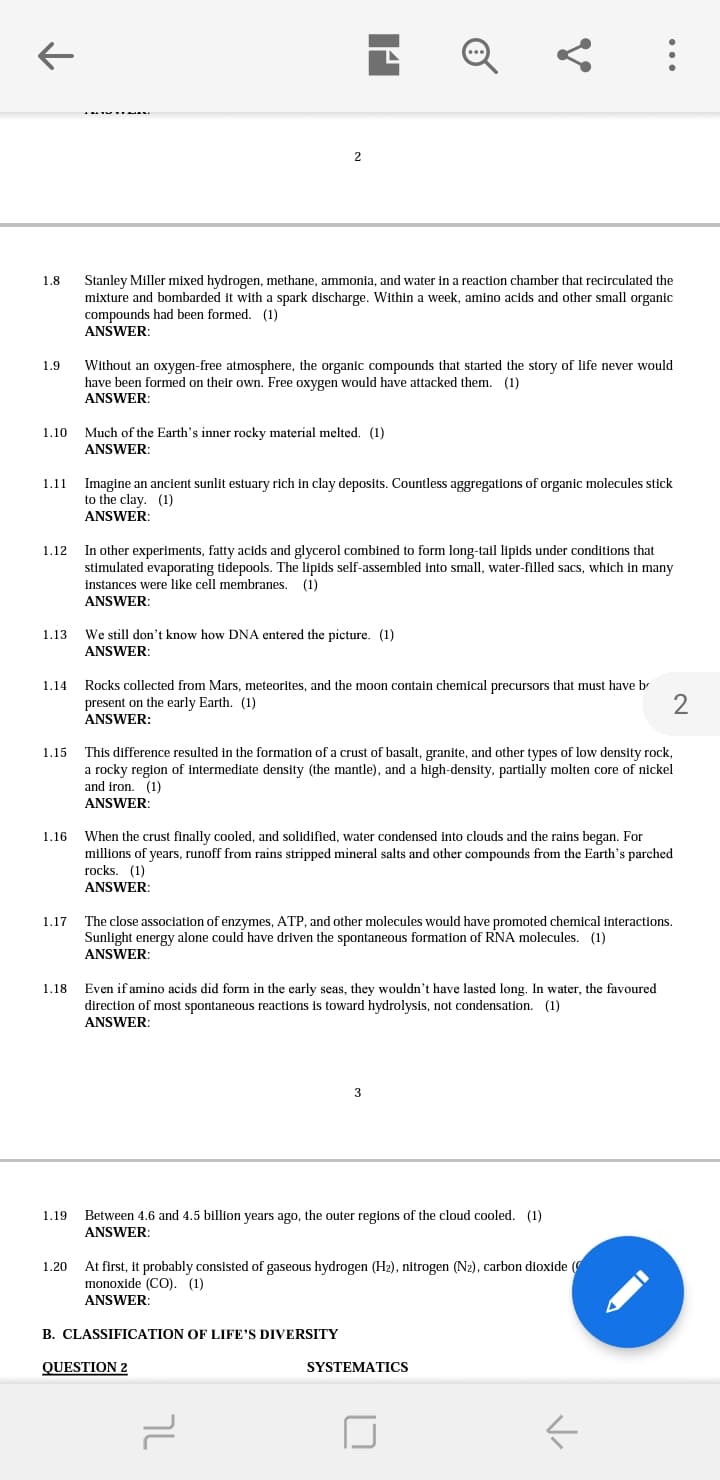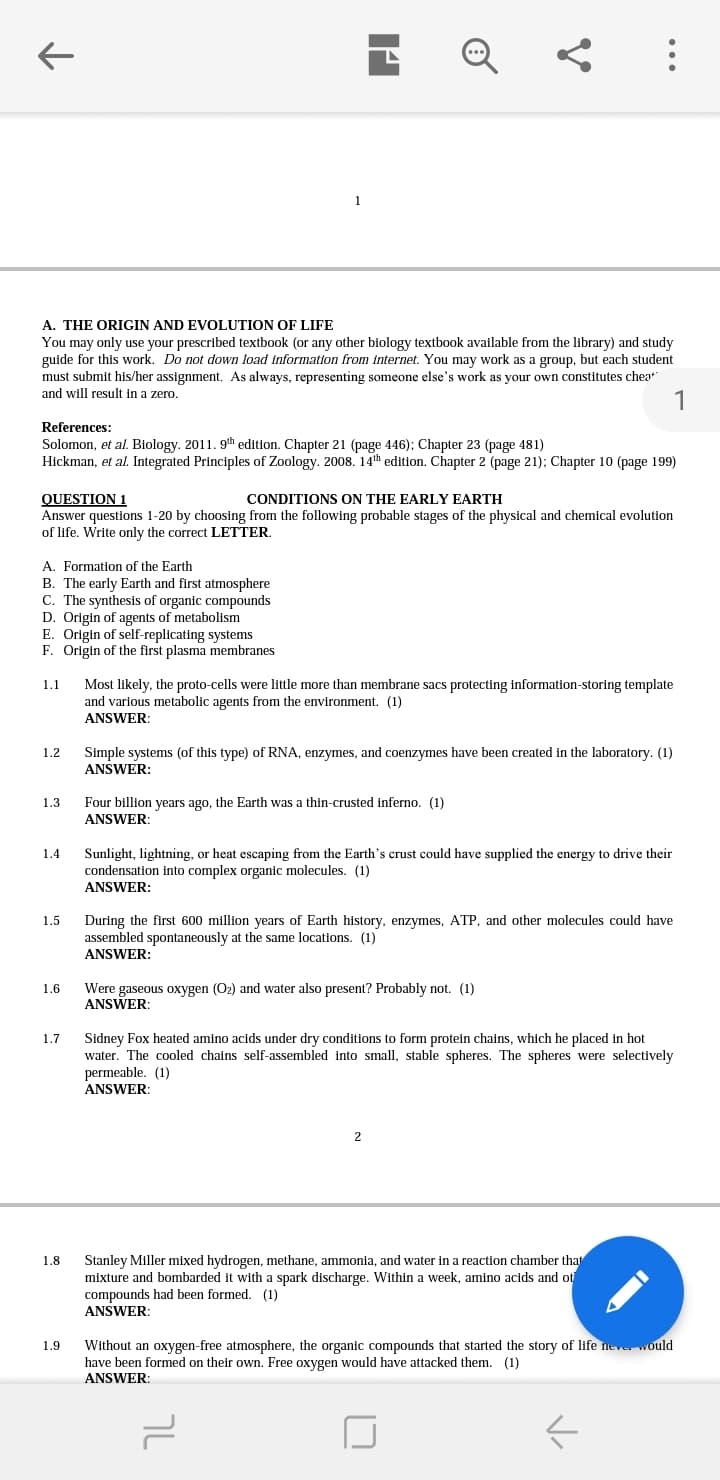1.8 1.9 Stanley Miller mixed hydrogen, methane, ammonia, and water in a reaction chamber that recirculated the mixture and bombarded it with a spark discharge. Within a week, amino acids and other small organic compounds had been formed. (1) ANSWER: Without an oxygen-free atmosphere, the organic compounds that started the story of life never would have been formed on their own. Free oxygen would have attacked them. (1) ANSWER: 1.10 Much of the Earth's inner rocky material melted. (1) ANSWER: 1.11 Imagine an ancient sunlit estuary rich in clay deposits. Countless aggregations of organic molecules stick to the clay. (1) ANSWER: 1.12 In other experiments, fatty acids and glycerol combined to form long-tail lipids under conditions that stimulated evaporating tidepools. The lipids self-assembled into small, water-filled sacs, which in many instances were like cell membranes. (1) ANSWER: 1.13 We still don't know how DNA entered the picture. (1) ANSWER: 1.14 Rocks collected from Mars, meteorites, and the moon contain chemical precursors that must have b present on the early Earth. (1) ANSWER: 2
1.8 1.9 Stanley Miller mixed hydrogen, methane, ammonia, and water in a reaction chamber that recirculated the mixture and bombarded it with a spark discharge. Within a week, amino acids and other small organic compounds had been formed. (1) ANSWER: Without an oxygen-free atmosphere, the organic compounds that started the story of life never would have been formed on their own. Free oxygen would have attacked them. (1) ANSWER: 1.10 Much of the Earth's inner rocky material melted. (1) ANSWER: 1.11 Imagine an ancient sunlit estuary rich in clay deposits. Countless aggregations of organic molecules stick to the clay. (1) ANSWER: 1.12 In other experiments, fatty acids and glycerol combined to form long-tail lipids under conditions that stimulated evaporating tidepools. The lipids self-assembled into small, water-filled sacs, which in many instances were like cell membranes. (1) ANSWER: 1.13 We still don't know how DNA entered the picture. (1) ANSWER: 1.14 Rocks collected from Mars, meteorites, and the moon contain chemical precursors that must have b present on the early Earth. (1) ANSWER: 2
Biology (MindTap Course List)
11th Edition
ISBN:9781337392938
Author:Eldra Solomon, Charles Martin, Diana W. Martin, Linda R. Berg
Publisher:Eldra Solomon, Charles Martin, Diana W. Martin, Linda R. Berg
Chapter22: The Evolution Of Primates
Section: Chapter Questions
Problem 11TYU
Related questions
Question
the process of categorizing phylogenetic information into a retrieval system consisting of many hierarchical levels or ranks.

Transcribed Image Text:2
Stanley Miller mixed hydrogen, methane, ammonia, and water in a reaction chamber that recirculated the
mixture and bombarded it with a spark discharge. Within a week, amino acids and other small organic
compounds had been formed. (1)
1.8
ANSWER:
Without an oxygen-free atmosphere, the organic compounds that started the story of life never would
have been formed on their own. Free oxygen would have attacked them. (1)
ANSWER:
1.9
Much of the Earth's inner rocky material melted. (1)
ANSWER:
1.10
Imagine an ancient sunlit estuary rich in clay deposits. Countless aggregations of organic molecules stick
to the clay. (1)
1.11
ANSWER:
In other experiments, fatty acids and glycerol combined to form long-tail lipids under conditions that
stimulated evaporating tidepools. The lipids self-assembled into small, water-filled sacs, which in many
instances were like cell membranes. (1)
1.12
ANSWER:
1.13
We still don't know how DNA entered the picture. (1)
ANSWER:
1.14 Rocks collected from Mars, meteorites, and the moon contain chemical precursors that must have b
present on the early Earth. (1)
2
ANSWER:
This difference resulted in the formation of a crust of basalt, granite, and other types of low density rock,
a rocky region of intermediate density (the mantle), and a high-density, partially molten core of nickel
and iron. (1)
1.15
ANSWER:
When the crust finally cooled, and solidified, water condensed into clouds and the rains began. For
millions of years, runoff from rains stripped mineral salts and other compounds from the Earth's parched
rocks. (1)
1.16
ANSWER:
The close association of enzymes, ATP, and other molecules would have promoted chemical interactions.
Sunlight energy alone could have driven the spontaneous formation of RNA molecules. (1)
1.17
ANSWER:
Even if amino acids did form in the early seas, they wouldn't have lasted long. In water, the favoured
direction of most spontaneous reactions is toward hydrolysis, not condensation. (1)
ANSWER:
1.18
3
1.19
Between 4.6 and 4.5 billion years ago, the outer regions of the cloud cooled. (1)
ANSWER:
At first, it probably consisted of gaseous hydrogen (H2), nitrogen (N2), carbon dioxide (
monoxide (CO). (1)
1.20
ANSWER:
B. CLASSIFICATION OF LIFE'S DIVERSITY
QUESTION 2
SYSTEMATICS

Transcribed Image Text:1
A. THE ORIGIN AND EVOLUTION OF LIFE
You may only use your prescribed textbook (or any other biology textbook available from the library) and study
guide for this work. Do not down load information from internet. You may work as a group, but each student
must submit his/her assignment. As always, representing someone else's work as your own constitutes chea
and will result in a zero.
1
References:
Solomon, et al. Biology. 2011. 9th edition. Chapter 21 (page 446); Chapter 23 (page 481)
Hickman, et al. Integrated Principles of Zoology. 2008. 14th edition. Chapter 2 (page 21); Chapter 10 (page 199)
QUESTION 1
Answer questions 1-20 by choosing from the following probable stages of the physical and chemical evolution
of life. Write only the correct LETTER.
CONDITIONS ON THE EARLY EARTH
A. Formation of the Earth
B. The early Earth and first atmosphere
C. The synthesis of organic compounds
D. Origin of agents of metabolism
E. Origin of self-replicating systems
F. Origin of the first plasma membranes
Most likely, the proto-cells were little more than membrane sacs protecting information-storing template
and various metabolic agents from the environment. (1)
ANSWER:
1.1
Simple systems (of this type) of RNA, enzymes, and coenzymes have been created in the laboratory. (1)
ANSWER:
1.2
1.3
Four billion years ago, the Earth was a thin-crusted inferno. (1)
ANSWER:
Sunlight, lightning, or heat escaping from the Earth's crust could have supplied the energy to drive their
condensation into complex organic molecules. (1)
ANSWER:
1.4
1.5
During the first 600 million years of Earth history, enzymes, ATP, and other molecules could have
assembled spontaneously at the same locations. (1)
ANSWER:
Were gaseous oxygen (O2) and water also present? Probably not. (1)
ANSWER:
1.6
Sidney Fox heated amino acids under dry conditions to form protein chains, which he placed in hot
water. The cooled chains self-assembled into small, stable spheres. The spheres were selectively
permeable. (1)
1.7
ANSWER:
2
Stanley Miller mixed hydrogen, methane, ammonia, and water in a reaction chamber that
mixture and bombarded it with a spark discharge. Within a week, amino acids and ot
compounds had been formed. (1)
1.8
ANSWER:
Without an oxygen-free atmosphere, the organic compounds that started the story of life neve would
have been formed on their own. Free oxygen would have attacked them. (1)
ANSWER:
1.9
...
Expert Solution
This question has been solved!
Explore an expertly crafted, step-by-step solution for a thorough understanding of key concepts.
Step by step
Solved in 2 steps with 1 images

Knowledge Booster
Learn more about
Need a deep-dive on the concept behind this application? Look no further. Learn more about this topic, biology and related others by exploring similar questions and additional content below.Recommended textbooks for you

Biology (MindTap Course List)
Biology
ISBN:
9781337392938
Author:
Eldra Solomon, Charles Martin, Diana W. Martin, Linda R. Berg
Publisher:
Cengage Learning

Concepts of Biology
Biology
ISBN:
9781938168116
Author:
Samantha Fowler, Rebecca Roush, James Wise
Publisher:
OpenStax College

Biology (MindTap Course List)
Biology
ISBN:
9781337392938
Author:
Eldra Solomon, Charles Martin, Diana W. Martin, Linda R. Berg
Publisher:
Cengage Learning

Concepts of Biology
Biology
ISBN:
9781938168116
Author:
Samantha Fowler, Rebecca Roush, James Wise
Publisher:
OpenStax College